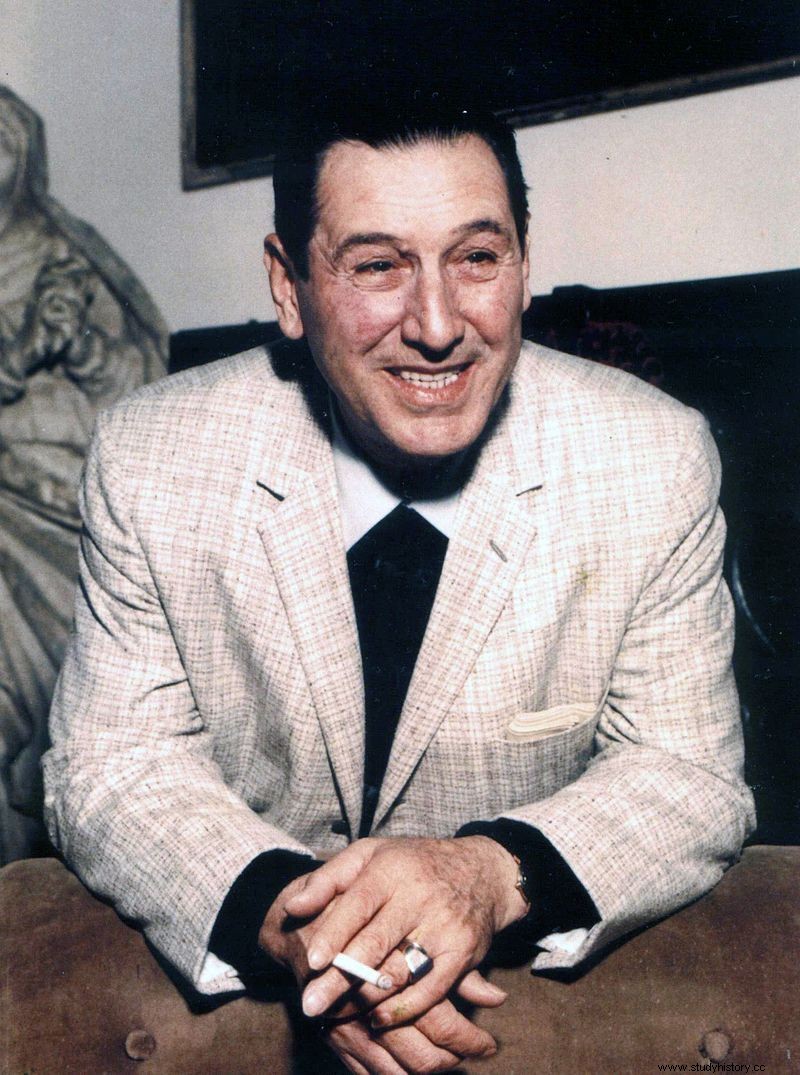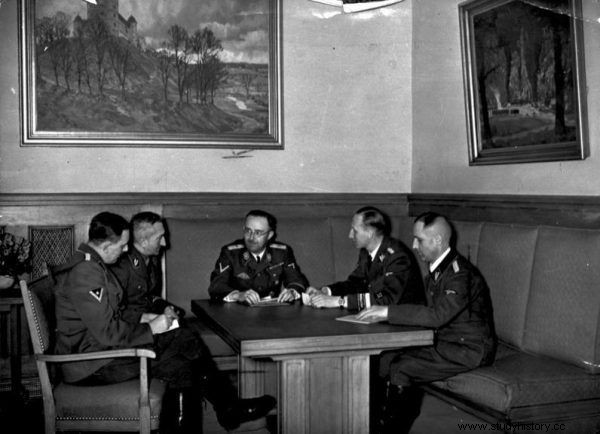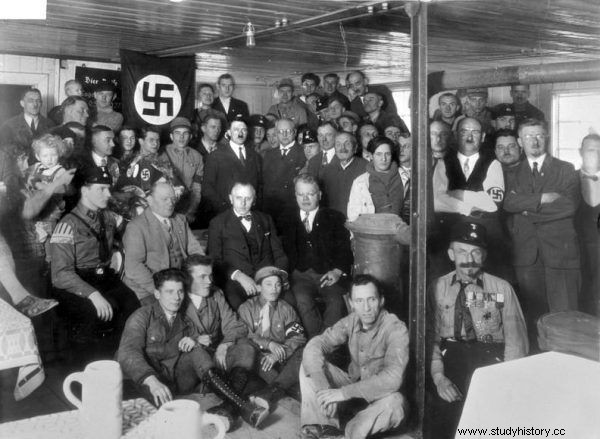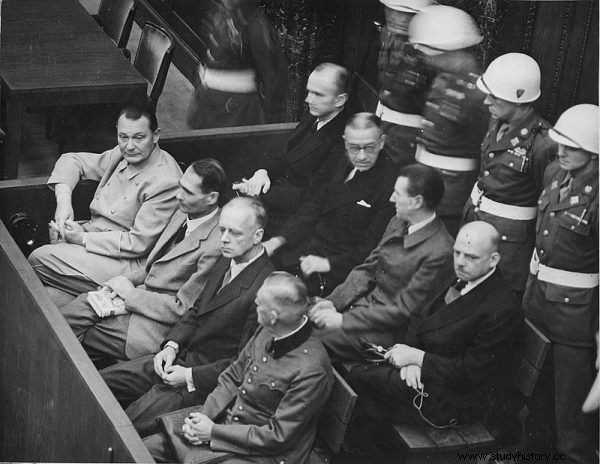After being abducted to Israel, he argued that he was only a rank-and-file official of the Third Reich, from whom - by mistake and cowardice of others - a scapegoat was made. He did not plead guilty to the end. Who, according to Adolf Eichmann and his German defender, was responsible for the deaths of millions of Jews?
He asked for a bottle of red wine and drank half of it. Crossing his hands behind his back, he walked erect from his cell to the execution chamber. - You don't have to He declared when they wanted to put him on a black hood. On May 31, 1962, Adolf Eichmann, the principal executor of the Nazi plan for the "Final Solution of the Jewish Question", was hanged in a jail in Ramala near Jerusalem.
On May 11, 1960, Eichmann was kidnapped by Israeli agents in a suburb of Buenos Aires. Nine days later, he was transferred by plane from the Argentine capital to Israel. On April 11, 1961, he heard the 15 most serious charges in the Jerusalem District Court. He was accused, inter alia, of committing crimes against the Jewish people, against humanity, and war crimes.
Philosophical arguments of historians
More than half a century has passed since the trial in Jerusalem, but historians still do not agree on how to classify Eichmann. The German philosopher and historian Bettina Stangneth in the book "Eichmann before Jerusalem" (its Polish translation has just appeared), which was published in 2011, writes that the "clerk for Jewish affairs" at the Reich Security Office (RSHA) is sometimes presented as a normal person, totalitarianism made a murderer. On another occasion, as an extreme anti-Semite and exterminator of Jews, or a mentally ill person whose regime of Hitler allowed him to indulge his sadistic tendencies .

The kidnapping of Adolf Eichmann from Argentina was another of the successes of the Mossad, the Israeli intelligence agency. The photo shows a Nazi criminal before the court.
The classic book about "SS-Obersturmbannführer retired" (Lieutenant Colonel), as Eichmann signed after his escape to Argentina, is the book "Eichmann in Jerusalem. A Thing About the Banality of Evil, by Hanna Arendt. A German-born Jewish woman who emigrated to the USA, a professor of philosophy and political science, followed the Eichmann trial in Jerusalem in 1961. Its presentation of the Holocaust immediately aroused controversy, especially among the Zionists and founders of the State of Israel. \
Bettina Stangneth's book "Eichmann Before Jerusalem" is partly a polemic with Hanna Arendt, as well as a summary of the current knowledge about the extermination of Jews based on materials for which neither the author of Eichmann in Jerusalem, nor other researchers in the early 1960s had access. Much of the so-called Sassen's interviews, recorded in Argentina during meetings of former officials of the Third Reich, were not made public until 1979. Even later, after 1998, several previously unknown Eichmann's emergence tapes were released. What we know today about the "Endlösung der Judenfrage", that is, the final solution to the Jewish question, calls into question Arendt's thesis about the "banality of evil".
Eichmann in a nutshell
The biography of a man who for Arendt was the epitome of the "banality of evil" is by no means trivial. In order to try to answer the question of whom Eichmann held responsible for the Holocaust, it is necessary to quote a few points from the biography of the Nazi criminal.
He joined the Nazi Party and the SS in 1932. Six years later - after the Anschluss of Austria - as head of the Central Office for the Emigration of Jews, he was transferred to Vienna. Then he ended up in Prague, and after the outbreak of World War II, he fulfilled himself as head of the department at the Reich Security Office (RSHA). In modern language, he was responsible for the logistics of transporting Jews from all over Europe to the East, where they were exterminated.

The RSHA, i.e. the Reich Main Security Office, was the state headquarters of the security police. It was established in 1939 by order of Heinrich Himmler. It was headed by Reinhard Heydrich (pictured right). On the left, the interior of the building at 8 Prinz-Albrecht-Straße (now Niederkirchnerstraße) in Berlin (then the seat of the RSHA).
During the infamous Wannsee conference in January 1942, the head of the RSHA, Reinhard Heydrich, made Eichmann the coordinator of the so-called the final solution of the Jewish question, i.e. the plan to murder some 11 million European Jews. As Bettina Stangneth writes in the book "Eichmann Before Jerusalem", the grateful subordinate did not spare himself at work; contrary. He was in Amsterdam, The Hague, Bratislava, Nice, Monaco, Paris, Copenhagen, Kiev and Königsberg. He visited ghettos (including Theresienstadt in the Czech Republic) and extermination camps (including Auschwitz), and at the end of the war he organized a murderous "final solution" for Hungarian Jews.
Because Eichmann knew he was a wanted war criminal, he hid his identity from the Americans. In POW camps he pretended to be a low-ranking SS man, Adolf Barth, and then Otto Eckmann. He escaped at the end of 1945 and, as a lumberjack, Otto Heninger, hid himself in a forest hut near Hamburg. In 1950, his escape to Argentina ruled by Juan Perón was made possible by a chain of German, Italian and Argentinean helpers, Red Cross workers and clerics from the Vatican .

In 1947, Juan Domingo Perón founded the Perónian Party, which preached a program of social justice. During his presidency, he created a fascist welfare state in Argentina:he not only introduced authoritarian rule, but also abolished freedom of association and freedom of work, and excommunicated the Catholic Church. A photo of Perón from around 1973.
Two comrades Sassen and Eichmann
For years, the public admired the investigative journalist Willem Sassen associated with the American magazine "Life", who allegedly managed to persuade Eichmann to tell the truth in Argentina. But Sassen was not at all the crystal man he wanted to be. In fact, he remained an anti-Semite, with a wartime background in the Dutch Waffen-SS volunteer unit. Nazi views did not prevent him from using Eichmann's "dear comrade" for profit. He befriended him and recorded his surfacing for several months.

The most frequently mentioned crime of Eichmann is his active participation in the extermination of Hungarian Jews. The Nazi criminal, however, claimed that he was responsible only for the transport, decisions were made outside of him. In the photo, Hungarian Jews in Auschwitz-Birkenau before being sent to the gas chambers.
After Eichmann was abducted by Israeli agents, Sassen sold some of the recordings to Life magazine (he cashed at least $ 20,000), and also traded extracts to the German weekly Stern and the Dutch daily De Volkskrant. At the same time, he tried to take responsibility off Hitler, Germany and the Reich. As if the murder of 6 million Jews was to be the sole responsibility of Eichmann.
Argentina. Eichmann is telling the truth
The recording sessions at Sassen's house in Buenos Aires lasted from April to October 1957. Today, historians have about a thousand pages of transcripts and 29 hours of recording, a 107-page SS manuscript, his notes and commentaries on books. All of this exposes Eichmann's lies at the trial in Jerusalem. According to what he said and wrote in Argentina, he was not a "cog in a machine" but a flywheel of the Holocaust. If he felt sorry, it was because he had not completely completed the task assigned to him.
- If out of these 10.3 million Jews (...) we killed 10.3 million Jews, I would be pleased and I would say, okay, we have destroyed the enemy. But because of the malice of fate, most of these 10.3 million Jews were alive, so I say to myself:fate willed it . (...) I am also complicit that this true, total elimination (...) could not be realized. (…) I was put in a position where (…) I should have done more - he said during one of the last recording sessions.

The article was written, among others based on the latest book by Bettina Stangneth "Eichmann Before Jerusalem" (Świat Książki 2017), which erased the image of one of the greatest Nazi criminals.
The mass killing made Eichmann proud:- When I received an order, I, for the executioner, always obeyed that order, and I am proud of it even today. If I hadn't, they wouldn't have gone to the butcher. He regretted the failure of the extermination of Jews in Denmark:- I had to cancel my transports, it was a devilish deception for me .
Jerusalem. Eichmann is lying
- I had nothing to do with killing Jews. I have never killed any Jew or non-Jew:I have never killed any human Eichmann claimed before an Israeli court. "I knew, but I could not change anything" - this is how his translations in Jerusalem could be summarized.
- By washing his hands, Pilate declares that he does not identify with the matter. (...) If I am allowed to compare myself with such a great historical figure, his situation was the same as mine He replied when the prison psychologist asked him about the Roman who handed over Christ to be crucified.

Gestapo chief Heinrich Müller (first from right) during a meeting of the German police. From left to right:SS officer Franz Josef Huber, Kripo chief Arthur Nebe, SS and police chief Heinrich Himmler and RSHA chief Reinhard Heydrich. Was Eichmann really just following their orders? The photo was taken in November 1939.
The haughty "SS-Obersturmbannführer retired" from the Argentine times turned into an obedient official, following the orders of Hitler, Himmler, Heydrich, his successor Ernst Kaltenbrunner and the head of the Gestapo, Heinrich Müller. He argued that "the words of the Führer had the force of law". Therefore, he would have killed his own father if he had only been instructed to do so. He claimed that at Wannsee - as the lowest-ranking - he was sitting politely at a side table, sharpening his pencils.
- I am not the monster that was made of me. I fell victim to a scam - he said and insisted that he had never been a "Jew-Eater". If he had been appointed commander of the extermination camp, like his friend Rudolf Höss (Auschwitz), he would have had to commit suicide because he could not kill. His fault came from being obedient, and obedience should be valued as an advantage.

The rule of the NSDAP was characterized by terror, total surveillance, liquidation of the opposition and a program of conquering Europe, accompanied by a plan to genocide the people of the conquered countries. The party leadership was recognized as a criminal organization in the Nuremberg trials. The photo shows the meeting of NSDAP members in 1930.
Eichmann no longer boasted about the liquidation of the millions of enemies of the Reich. The then German government, i.e. Hitler, his ministers and reichsleiters, i.e. the top management of the NSDAP, was given all responsibility . On the other hand, he was explaining the Führer, because there was a war going on, and he was "only fulfilling his duty" to destroy his opponents. Moreover, he had zealous helpers from other countries.
Eichmann accuses
In Slovakia, completely dependent on the Third Reich, ruled by a Catholic clergyman, Father Józef Tiso, the over 50,000 Jewish population was deported to extermination camps as early as 1942. Eichmann admitted at best to organize the transport. After all, the Slovak police had caught the Jews. .

The dock of defendants in Nuremberg. Seated from the left in the first row:Göring, Hess, Ribbentrop, Keitel. In the second row:Dönitz, Raeder, Schirach, Sauckel. Although Adolf Eichmann was not there, Israeli intelligence did not rest until they found him. In 1961, the Nazi criminal was put on trial in Jerusalem.
According to the Nazi criminal, it was similar in Hungary, as the author of "Eichmann before Jerusalem", Bettina Stangneth, writes. Miklós Horthy's puppet government sent him "his" Jews. Probably not efficiently enough, because in the last phase of the war the Germans overthrew Horthy and made Ferenc Szalasi the head of state. His wetboys in the middle of winter, without blinking an eye, sent 50,000 survivors of the previous "round-ups" of Hungarian Jews on murderous marches towards the Reich .
The most bizarre conspiracy theory suggested by Eichmann in Jerusalem is that a secret alliance existed from the very beginning between the Zionists seeking to establish a Jewish state in Palestine and the German National Socialists. The result of this conspiracy was to be the destruction by the Nazis of "non-Zionist Jews" and its final result - the emergence of a Jewish state.
